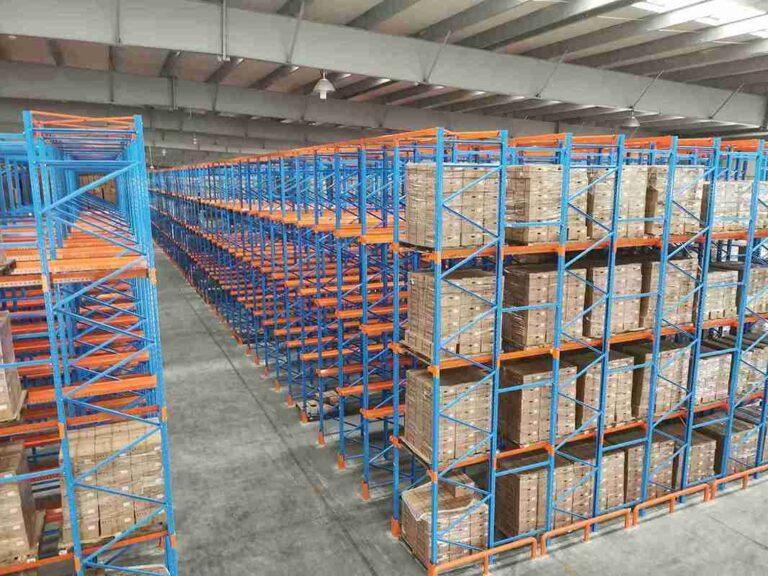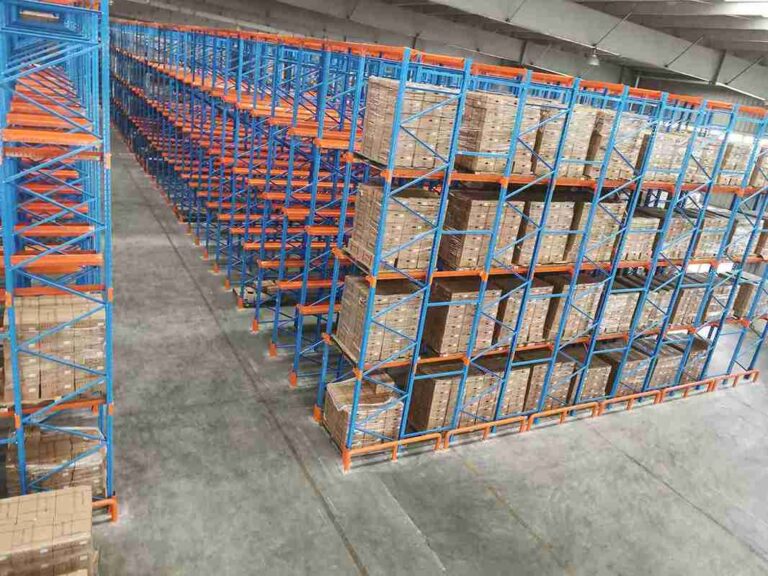📐 "First 50 Enterprise Queries Get Custom 3D Warehouse Design" Plan

Introduction: Revolutionizing Warehouse Storage with Drive-In Pallet Racking
In an era where warehouse space is at a premium, drive-in pallet racking has emerged as a game-changer for businesses needing high-density storage without compromising structural integrity. Unlike conventional selective racking, which requires multiple aisles for accessibility, drive-in pallet racking allows forklifts to enter the rack structure directly, dramatically increasing storage capacity while reducing wasted space.
This in-depth guide explores every facet of drive-in pallet racking, from its structural advantages to industry-specific applications, helping warehouse managers, logistics coordinators, and supply chain professionals determine if this system is the right fit for their operations.

H1: Understanding Drive-In Pallet Racking – A Deep Dive
Drive-in pallet racking is a high-density storage system engineered for warehouses storing large quantities of similar products. Unlike traditional selective racking, which provides direct access to every pallet, drive-in racking operates on a last-in, first-out (LIFO) principle, where forklifts drive directly into the rack to deposit or retrieve pallets.
H2: How Drive-In Pallet Racking Maximizes Space Efficiency
-
Eliminates unnecessary aisles, allowing deeper storage configurations.
-
Increases storage density by up to 75% compared to standard racking.
-
Reduces warehouse footprint, lowering real estate and operational costs.
H2: Core Components of a Drive-In Pallet Racking System
-
Heavy-Duty Vertical Frames – Reinforced steel columns designed to support multiple pallet levels.
-
Load Beams with High Weight Capacity – Engineered to handle substantial pallet loads without bending.
-
Guide Rails for Forklift Navigation – Ensures smooth and safe entry/exit for forklifts.
-
Pallets Stored in Continuous Rows – Optimized for bulk storage with minimal aisle interruptions.
H1: Why Drive-In Pallet Racking Outperforms Other Storage Systems
H2: Unmatched Storage Density & Cost Savings
-
Fewer aisles mean more pallet positions per square foot, making drive-in pallet racking ideal for warehouses with space constraints.
-
Lower construction costs since fewer structural supports are needed compared to multi-aisle systems.
-
Energy savings due to reduced lighting and HVAC requirements in condensed storage zones.
H2: Ideal for High-Volume, Low-SKU Inventory
-
Perfect for beverage distributors, food storage, and cold storage facilities, where large quantities of identical products are stored.
-
Excellent for seasonal inventory, such as holiday merchandise or agricultural bulk storage.
H2: Enhanced Durability & Long-Term ROI
-
Built with heavy-duty steel, drive-in pallet racking withstands years of heavy use.
-
Lower maintenance costs compared to more complex automated systems.
H1: Drive-In Pallet Racking vs. Competing High-Density Systems
H2: Drive-In vs. Push-Back Racking – Which is Better?
| Feature | Drive-In Pallet Racking | Push-Back Racking |
|---|---|---|
| Access Method | LIFO only | LIFO or FIFO options |
| Storage Depth | Up to 10 pallets deep | Typically 2-6 pallets deep |
| Cost Efficiency | Lower initial investment | Higher due to cart systems |
H2: Drive-In vs. Pallet Flow Racking – When to Choose Each
-
Drive-in pallet racking excels in long-term bulk storage with infrequent turnover.
-
Pallet flow racking (gravity-fed) is better for FIFO operations like perishable goods.
H1: Top Industries Benefiting from Drive-In Pallet Racking
H2: Food & Beverage Distribution
-
Bottled drinks, canned goods, and packaged foods are stored efficiently in drive-in pallet racking due to uniform pallet sizes.
-
Cold storage warehouses maximize space in temperature-controlled environments.
H2: Manufacturing & Industrial Storage
-
Raw materials, automotive parts, and construction supplies benefit from deep storage configurations.
-
Chemical and pharmaceutical storage where bulk pallet handling is required.
H2: Retail & E-Commerce Fulfillment
-
Seasonal inventory peaks (e.g., Black Friday, holiday stock) are managed efficiently.
-
Large-scale e-commerce warehouses use drive-in pallet racking for overstock items.
H1: Designing an Optimized Drive-In Pallet Racking System
H2: Warehouse Layout & Space Utilization Strategies
-
Minimum aisle width of 10-12 feet for safe forklift operation.
-
Optimal rack height based on forklift reach capabilities (typically up to 40 feet).
H2: Load Capacity & Structural Integrity
-
Beam strength must match pallet weights (standard capacities range from 2,000 to 10,000 lbs per beam).
-
Seismic reinforcement for warehouses in earthquake-prone regions.
H2: Forklift Compatibility & Operator Training
-
Narrow-aisle forklifts are ideal for deeper racking configurations.
-
Mandatory operator training to prevent collisions and rack damage.
H1: Installation & Maintenance Best Practices for Longevity
H2: Professional Installation Guidelines
-
Certified racking installers ensure proper alignment and load distribution.
-
Anchor bolts and floor flatness checks prevent structural instability.
H2: Routine Maintenance & Safety Inspections
-
Monthly checks for beam deflection or column damage.
-
Yearly structural integrity assessments by warehouse engineers.
H1: Overcoming Common Challenges with Drive-In Pallet Racking
H2: Slow Inventory Turnover Solutions
-
Reserve drive-in pallet racking for slow-moving SKUs.
-
Combine with selective racking for faster-moving inventory.
H2: Preventing Forklift Damage & Accidents
-
Impact guards and column protectors minimize collision damage.
-
Strict speed limits and aisle discipline for forklift operators.
H1: The Future of Drive-In Pallet Racking & Automation Trends
-
Automated guided vehicles (AGVs) for driverless pallet retrieval.
-
Hybrid systems integrating drive-in racking with shuttle technology.
Conclusion: Is Drive-In Pallet Racking Right for Your Warehouse?
Drive-in pallet racking remains one of the most cost-effective, high-density storage solutions available today. Its ability to maximize storage space, reduce operational costs, and handle bulk inventory efficiently makes it indispensable for industries like food & beverage, manufacturing, and cold storage.
For businesses considering drive-in pallet racking, proper design, installation, and maintenance are critical to long-term success. If your warehouse handles large volumes of uniform products, implementing drive-in pallet racking could be the key to unlocking unprecedented storage efficiency.
FAQs: Expert Answers to Common Drive-In Pallet Racking Questions
1. What is the typical lifespan of a drive-in pallet racking system?
With proper maintenance, drive-in pallet racking can last 20+ years, depending on usage and environmental conditions.
2. Can drive-in pallet racking be reconfigured for different pallet sizes?
Yes, adjustable beams allow customization for various pallet dimensions.
3. What are the weight limits for drive-in pallet racking?
Standard systems support 2,000–10,000 lbs per beam, with heavy-duty options available.
4. Is drive-in pallet racking suitable for perishable goods?
Only if using FIFO alternatives, as drive-in racking follows LIFO retrieval.
5. How can I improve safety in a drive-in pallet racking system?
-
Regular inspections
-
Forklift operator training
-
Impact protection systems
By leveraging drive-in pallet racking, warehouses can achieve unmatched storage density, cost savings, and operational efficiency—making it a top choice for modern logistics operations.



